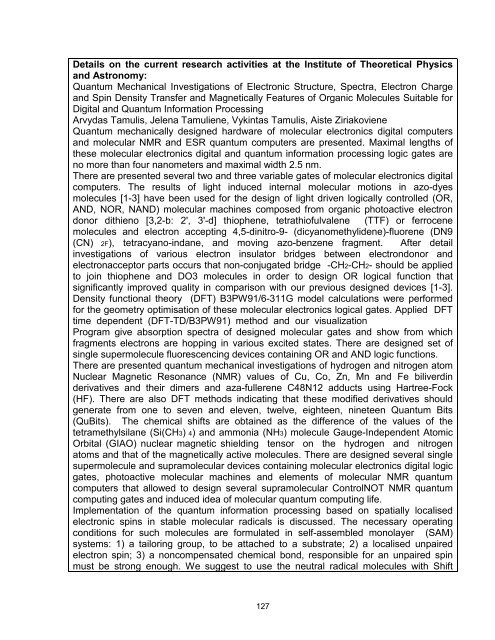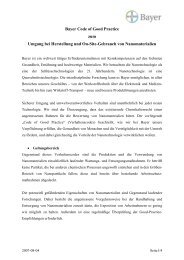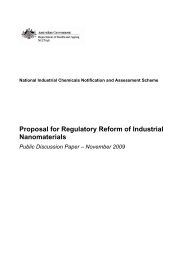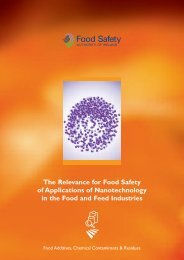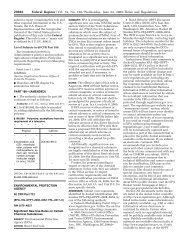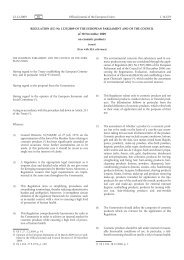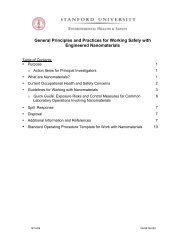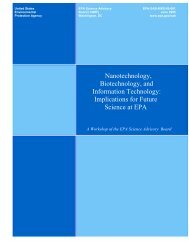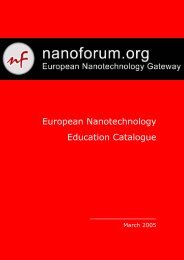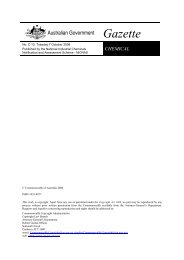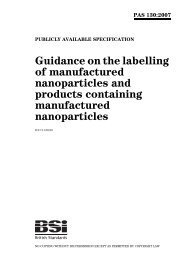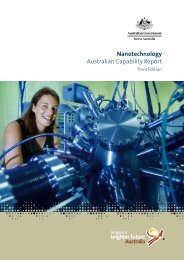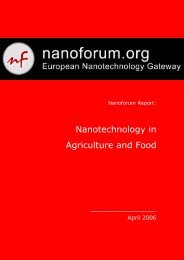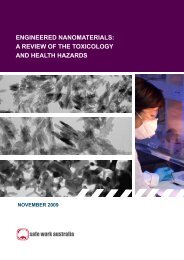Nanoforum - Nanotech Regulatory Document Archive
Nanoforum - Nanotech Regulatory Document Archive
Nanoforum - Nanotech Regulatory Document Archive
You also want an ePaper? Increase the reach of your titles
YUMPU automatically turns print PDFs into web optimized ePapers that Google loves.
Details on the current research activities at the Institute of Theoretical Physics<br />
and Astronomy:<br />
Quantum Mechanical Investigations of Electronic Structure, Spectra, Electron Charge<br />
and Spin Density Transfer and Magnetically Features of Organic Molecules Suitable for<br />
Digital and Quantum Information Processing<br />
Arvydas Tamulis, Jelena Tamuliene, Vykintas Tamulis, Aiste Ziriakoviene<br />
Quantum mechanically designed hardware of molecular electronics digital computers<br />
and molecular NMR and ESR quantum computers are presented. Maximal lengths of<br />
these molecular electronics digital and quantum information processing logic gates are<br />
no more than four nanometers and maximal width 2.5 nm.<br />
There are presented several two and three variable gates of molecular electronics digital<br />
computers. The results of light induced internal molecular motions in azo-dyes<br />
molecules [1-3] have been used for the design of light driven logically controlled (OR,<br />
AND, NOR, NAND) molecular machines composed from organic photoactive electron<br />
donor dithieno [3,2-b: 2', 3'-d] thiophene, tetrathiofulvalene (TTF) or ferrocene<br />
molecules and electron accepting 4,5-dinitro-9- (dicyanomethylidene)-fluorene (DN9<br />
(CN) 2F), tetracyano-indane, and moving azo-benzene fragment. After detail<br />
investigations of various electron insulator bridges between electrondonor and<br />
electronacceptor parts occurs that non-conjugated bridge -CH2-CH2- should be applied<br />
to join thiophene and DO3 molecules in order to design OR logical function that<br />
significantly improved quality in comparison with our previous designed devices [1-3].<br />
Density functional theory (DFT) B3PW91/6-311G model calculations were performed<br />
for the geometry optimisation of these molecular electronics logical gates. Applied DFT<br />
time dependent (DFT-TD/B3PW91) method and our visualization<br />
Program give absorption spectra of designed molecular gates and show from which<br />
fragments electrons are hopping in various excited states. There are designed set of<br />
single supermolecule fluorescencing devices containing OR and AND logic functions.<br />
There are presented quantum mechanical investigations of hydrogen and nitrogen atom<br />
Nuclear Magnetic Resonance (NMR) values of Cu, Co, Zn, Mn and Fe biliverdin<br />
derivatives and their dimers and aza-fullerene C48N12 adducts using Hartree-Fock<br />
(HF). There are also DFT methods indicating that these modified derivatives should<br />
generate from one to seven and eleven, twelve, eighteen, nineteen Quantum Bits<br />
(QuBits). The chemical shifts are obtained as the difference of the values of the<br />
tetramethylsilane (Si(CH3) 4) and ammonia (NH3) molecule Gauge-Independent Atomic<br />
Orbital (GIAO) nuclear magnetic shielding tensor on the hydrogen and nitrogen<br />
atoms and that of the magnetically active molecules. There are designed several single<br />
supermolecule and supramolecular devices containing molecular electronics digital logic<br />
gates, photoactive molecular machines and elements of molecular NMR quantum<br />
computers that allowed to design several supramolecular ControlNOT NMR quantum<br />
computing gates and induced idea of molecular quantum computing life.<br />
Implementation of the quantum information processing based on spatially localised<br />
electronic spins in stable molecular radicals is discussed. The necessary operating<br />
conditions for such molecules are formulated in self-assembled monolayer (SAM)<br />
systems: 1) a tailoring group, to be attached to a substrate; 2) a localised unpaired<br />
electron spin; 3) a noncompensated chemical bond, responsible for an unpaired spin<br />
must be strong enough. We suggest to use the neutral radical molecules with Shift<br />
127


